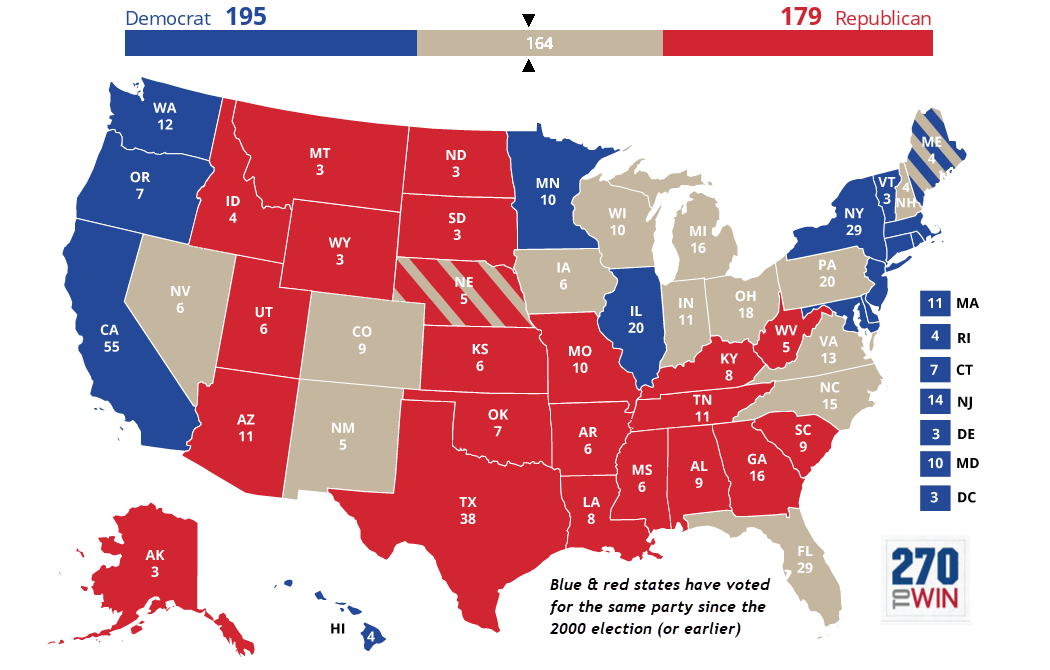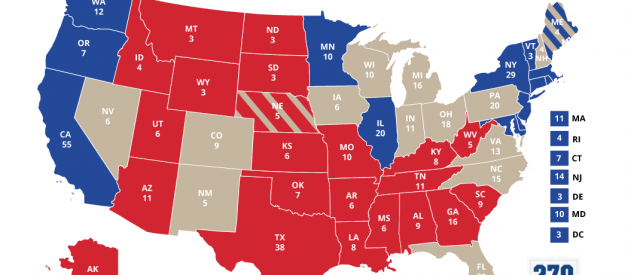 Image Source: 270towin. ?2020 Presidential Map.? https://www.270towin.com/
Image Source: 270towin. ?2020 Presidential Map.? https://www.270towin.com/
NOTE: If you want to play around with an electoral college map to see what kinds of electoral vote combinations you can make, visit https://www.270towin.com/ to make your own map.
Anyone who has watched any coverage of a presidential election has more than likely heard of the concepts of ?red? and ?blue? states. The media zeroes in on these distinctions so heavily that it sometimes can sound like what colors the states go in an election are all that matters, where red designates a state voting mostly Republican and blue designates a state voting mostly Democratic. A few states are ?purple? where they swing back and forth from election to election.
The concepts are relatively new in politics. They are also often shortsighted, broad-brush strokes of the states that give an inaccurate depiction of how the politics of each state really function. How states vote in presidential elections isn?t all that matters. The states can be different in presidential votes than who they pick for governor and state legislatures, and the voting population?s party affiliation may yet go another way. Then there can be pockets of the minority party or even unaffiliated voters (also called NPAs, or no-party affiliates) that are glossed over in the media?s overzealous labelings of the states.
So, how did we even get to calling states red, blue, or purple? We explore that, along with a more in-depth look at the issues in the categorizations and what their implications are, in today?s topic.
The Origin of Red and Blue
The concept of red and blue is relatively new, and even what they mean has changed in the time since. In fact, when the terms were introduced into presidential election coverage, some media outlets used blue to mean Republican and red to mean Democratic instead of the other way around we have today (blue is typically associated with conservative parties of other countries such as some of those in Europe, hence their original association with Republicans).
Red and blue state terminology were first used in 1976 when Democrat Jimmy Carter ran against Republican Gerald Ford. Ford had taken over in place of Richard Nixon after his resignation following Watergate (and Vice President Spiro Agnew?s resignation following a charge of tax evasion). Although blue was usually Republican and red was usually Democrat, this wasn?t uniform as other media would flip the colors the other way around. It wasn?t until the hotly contested 2000 election between George W. Bush and Al Gore that the colors were applied consistently ? red for Republican, blue for Democrat.
While there are many states that tend to go red or blue, there are still some ?swing? states that go back and forth. Thus, red and blue are combined into ?purple? states, such as Florida, Ohio, and Virginia.
Where Red/Blue/Purple Categorizations Apply
Like with many things in politics, a broadly-applied label can mask a lot of the detail and nuance in all of the states. The colors may be useful heuristics for the public when listening to presidential election coverage, but sometimes an assumption will follow that the whole state operates the same way at all of the other levels of government or that the state overwhelmingly leans a certain way politically. Such an assumption can often be faulty.
Of course, some states unequivocally lean one way and/or mostly operate in that direction. Just about any way you cut it, Hawaii is a deep blue state, although because of its small size it doesn?t garner much attention. It votes Democratic in presidential elections, it currently has a Democratic governor and lieutenant governor (although Republican Linda Lingle was governor from 2002 to 2010), the congressional delegation is all Democratic, and 70 of the 76 state legislators are Democrats.
Wyoming is a similar case, except that it is a deep red state. It votes Republican in presidential elections, has an all-Republican congressional delegation, 77 of 90 state legislators are Republicans, and all of the elected state executive offices in Wyoming (governor, attorney general, secretary of state, state auditor, and superintendent of public instruction) are all Republicans.
Virginia largely fulfills its reputation as a purple state beyond its recent presidential voting history. At first glance, its congressional delegation (9 of 14 are Democrats, including its 2 U.S. Senators) and all four of the state?s partisan executive offices being Democrats may lead to the casual observer?s conclusion that the state is otherwise solidly Democratic. Yet both chambers of its state legislature are controlled by Republicans, albeit with incredibly thin majorities in both. So, the executive branch of Virginia is blue, the legislative branch is red, and it goes back and forth in presidential elections.
Beyond these three states and some other examples, however, the picture can get a bit muddled.
Florida is most certainly a purple state in how it votes in presidential elections. Yet the state government is firmly in Republican control and has been for most of the 21st century. Except for the recently-elected Democratic Commissioner of Agriculture Nikki Fried, the other three elected state executive offices of governor, attorney general, and chief financial officer are Republicans. Both the state house and senate are solidly red. This is despite the fact that there are roughly 250,000 or so more registered Democrats in the state than Republicans (and Republicans have never been a larger number than Democrats in the state?s history).
Ohio is another state normally considered purple in presidential elections that tells a different story with its state government as well. Nine of its ten partisan executive offices are Republicans, and Republicans outnumber Democrats in the State House 61 to 38 and in the State Senate 23 to 9 (with 1 vacancy). It is not clear how the voting population leans as Ohio is one of the states that does not register its voters under party labels.
To be clear, this is not to say that the red and blue designations are mostly useless. They are sometimes accurate and can be useful heuristics in some cases. There is a critique to be made, however, that a heavy reliance on them with only a cursory glance at a state?s politics can give a mistaken impression.
In fairness, somewhat of a counterargument can be made to this critique in the number of state government trifectas in the country. The basic definition of a trifecta is when a one party in a state holds the governor?s office and majorities in both state legislative chambers (house and senate). The 2018 election resulted in 36 state government trifectas, and most of them were in place prior to the election.
On a closely related note, one can also point to the number of state legislatures unified under one party. Here is an excerpt from my article a couple of weeks ago on the recent history of partisan control of state legislatures:
As discussed at the beginning of this article, however, Democrats found some success in reversing this trend as part of the ?blue wave? predictions for 2018. The number of Republican-controlled states was whittled down slightly to 30, but Democrats gained unified control of four more legislatures to make their total 18.? Only one state legislature, Colorado, has a split legislature, with its Senate belonging to Republicans and its House belonging to Democrats.? (There are a couple caveats to note. Connecticut?s State Senate is actually evenly divided between the two parties at 18 apiece. Alaska is also technically split because ? although there are more Republicans than Democrats in their state house ? a coalition between the Democrats, three Republicans, and two independents effectively gives majority control of Alaska?s State House to the Democratic Party. Here, however, Alaska is considered to be unified under Republicans.)
With over 90% of state legislatures falling under one party?s banner and the number of state government trifectas, there is undeniably some solidification of red and blue going on. The point being made in this article, however, is that the simple designation of ?red? and ?blue? (and ?purple?) can miss the details or imply that many states overwhelmingly lean one way or the other that it can seem impossible to go the other way.
What Red and Blue States Mean for the Future
Red and blue states have implications beyond simply where their politics lean and what policy goals governments might pursue. There is evidence that people are moving more and more into like-minded communities and even states. However, there is some debate as to just how many people are doing this, how many are doing so deliberately, and how many people actually care about it (a topic which could certainly take up its own article). Still, many states have become fairly predictable in how they vote for president and clearly lean one way or the other.
But politics always has some surprises in store, and an eventual change in how the parties are sorted out geographically is far from unprecedented. One such significant change occurred in the 1960s. The once ?Solid South? that was reliably Democratic became noticeably more Republican. Some of the states that used to be Republican in the north turned Democratic. It arguably is still having a bit of carryover in some places.
Still, such a radical change in geographical sorting is unlikely to occur anytime soon. For now, much of the landscape is reliably red or blue. And the purple ones are going to keep largely deciding elections.
- Ron Elving. NPR. ?The Color of Politics: How Did Red and Blue States Come to Be?? https://www.npr.org/2014/11/13/363762677/the-color-of-politics-how-did-red-and-blue-states-come-to-be (accessed January 16, 2019).
- Ballotpedia. ?State government trifectas.? https://ballotpedia.org/State_government_trifectas (accessed January 17, 2019).


